063
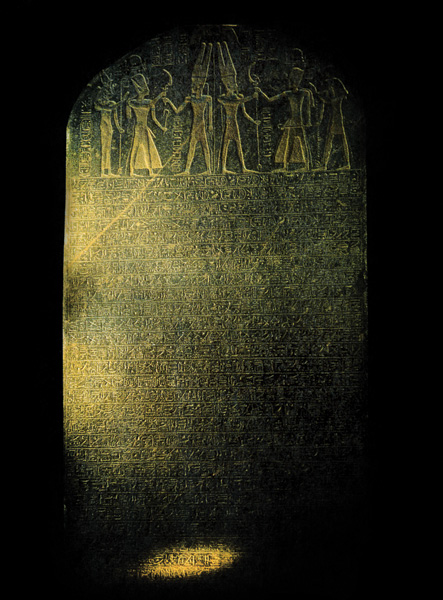
It used to be easy to identify the earliest Israelites. They are referred to in a well-known hieroglyphic stele known as the Merneptah Stele or, sometimes, the Israel Stele. The Egyptian pharaoh Merneptah, the son of Ramesses II, proclaims in this stele dated to the end of the 13th century B.C.E. that “Israel is laid waste, his seed is not.”
There is no question about the translation of the hieroglyphic signs: They say “Israel.” Attached to the word “Israel” is a non-phonetic (unpronounced) hieroglyphic sign that indicates this word is a people, not a city-state like the other places (Ashkelon, Gezer and Yenoam) mentioned in the same pericope as Israel. These other places bear a different nonphonetic hieroglyphic sign (called a determinative) indicating that they are, in contrast to Israel, city-states. In short, Israel is a people. The other names are city-states.
In about 1200 B.C.E., the Late Bronze Age came to an end and was followed by Iron Age I, which extended from about 1200 to 1000 B.C.E. According to traditional scholarship, this 200-year archaeological period can be identified with the Biblical period 064of the “settlement and judges,” prior to the formation of the Israelite monarchy in the tenth century B.C.E.
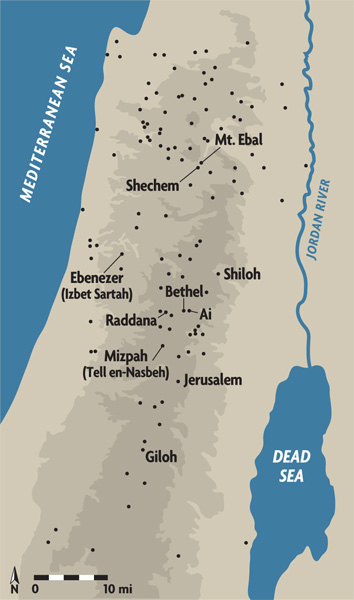
In Iron Age I, hundreds of small villages were established in the highlands of ancient Canaan (on both sides of the Jordan River). Among them are Khirbet Raddana, Ai, Giloh, Shiloh, Izbet Sartah, Mt. Ebal and many others. These sites were identified as the settlement of the Israelite tribes in the region. The sites are small—usually less than three acres (1 hectare)—and have a very rudimentary material culture. The pottery repertoire is limited to simple, undecorated vessels—mainly storage jars of the type known as collared-rim jars, along with bowls and cooking pots. Imported wares are absent. These sites are unfortified, and many of the buildings belong to the archetype of what later became known as the four-room house, the typical house of Israelite architecture. No public buildings have been unearthed in these villages.
Although scholars hotly debated the process by which these settlements were established (whether as a result of conquest, a peaceful “settling down,” “social revolution” or some other theory), there was a consensus that the settlers were Israelites.
Today, however, a number of scholars seriously doubt the Israelite identity of these settlers. Initially, doubts were raised because archaeologists had not identified the Jebusites, the Gibeonites or other Canaanite groups mentioned in the Bible and which were supposed to have lived in the highlands during Iron Age I (Numbers 13:29). The fact that these other groups were not identified and distinguished from the Israelites raised doubts as to the identification of the highland material culture as Israelite. Moreover, the fact that various material traits that were considered Israelite were also found in “non-Israelite” regions (i.e., the northern valleys) also led to growing skepticism regarding the identification of those material traits with the Israelites.
At the same time these doubts were being raised about identifying the Israelites with these small highland settlements, a more fundamental change was occurring in archaeological thinking generally. Beginning in the 1960s and 1970s, the so-called New Archaeology, later known as processual archaeology, was becoming increasingly influential. Processual archaeologists were looking for “covering laws” to help explain material culture evidence in a uniform and systematic way. Archaeologists working in this tradition viewed archaeology as a behavioral science whose aim was to arrive at general laws of human behavior. Naturally, these archaeologists were less interested in particularities like ethnicity. Although the New Archaeology was never adopted on a wide scale among Biblical archaeologists, indirectly it had significant influence on academic interests and was largely responsible for the diminished importance attached to the study of ethnicity.
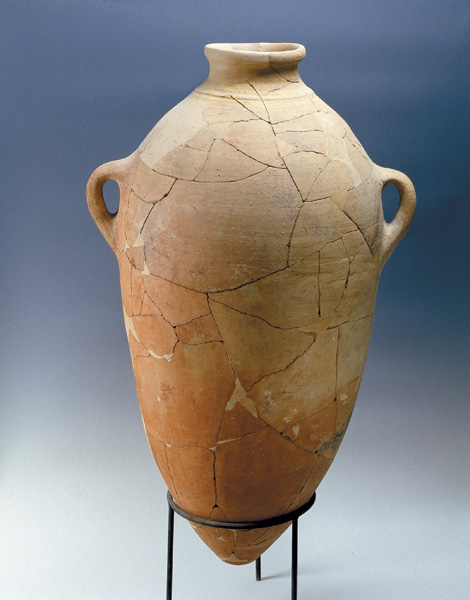
Then in the 1990s came the so-called Biblical minimalists who questioned even the existence of an ancient “Israel,” thus making the study of 065Israelite identity almost illegitimate.a
In addition, some of the hesitation to attribute ethnic labels to material culture stemmed from a more nuanced understanding of the concept of ethnicity. We now understand that the process by which an ethnic group comes into existence is complex and dynamic, and that ethnic identity is subjective. Moreover, people can change their ethnic identity and even have more than one identity at the same time. A so-called “archaeological culture”—a complex of finds repeatedly found together—cannot, therefore, be identified with an ethnic group.
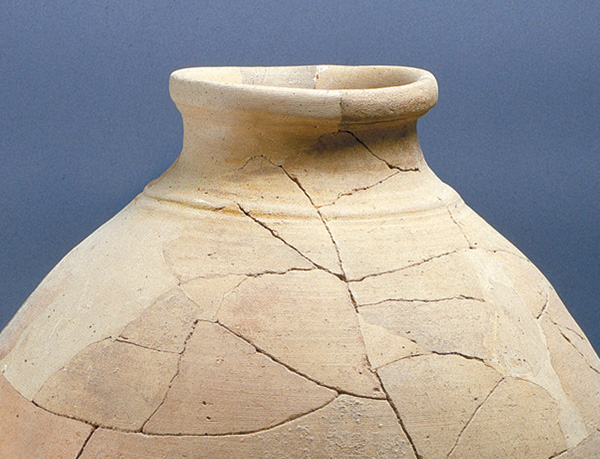
All this had an impact on the willingness of scholars to identify the Iron Age I highland settlers as Israelites.
Today many scholars prefer to avoid the term “Israelites” when referring to the people living at these highland sites. Some resort to the term “proto-Israelites,” since they agree, on the one hand, that the later offspring of these settlers were Israelites, but, on the other hand, argue that we do not really know how these settlers viewed themselves. Other scholars argue that there is no reason to call the highland settlers Israelites or proto-Israelites. According to their view, we should view these highland settlers simply as part of the Canaanite population of the country.
The mention of Israel in the Merneptah Stele is explained by these scholars in various ways. For example, we do not know where this “Israel” was located; hence there is no necessary connection between the group mentioned in the Merneptah Stele and the highland settlers. Other doubters have even suggested that “Israel” refers here only to a region, and not to an ethnic group (despite the determinative for “people” or at least a “group,” as all Egyptologists agree). The Israelites, according to these views, did not become an ethnic group until Iron Age II, the period of the monarchy (if even then, according to some Biblical minimalists).
This variety of views was obviously influenced by broader developments in the field, but it must be stressed that the various studies, from all schools of thought, approached Israel’s emergence from the viewpoint of political history, as part of a kind of “grand history.”
It seems to me, however, that although the question of Israel’s emergence in Canaan is no doubt an important theme within this “grand history,” it must be examined first as part of a social study of ancient Israel. Until recently, Biblical and Near Eastern archaeology has concentrated on political Biblical issues, but this traditional approach is insufficient to study a question as complex as ethnicity. I maintain that the key to the problem of Israelite ethnicity is in the study of Iron Age society, a subject that has not received much scholarly attention. This is because ethnicity is only one facet of social life, and people can have more than one identity—even group identity—at any given time.
We should first say a few words about the study of ethnicity on the basis of material finds. The view that ethnic identity is fixed and unchanging dominated early scholarship. Many scholars assumed that material culture reflects this fixed, unchanging identity and that an “archaeological culture” is the equivalent of a people or ethnic group. As the famous Australian archaeologist Gordon Childe once phrased it: “We find certain types of remains—pots, implements, ornaments, burial rites and house forms—constantly recurring together. 066Such a complex of associated traits we shall term a ‘cultural group’ or just a ‘culture.’ We assume that such a complex is the material expression of what today would be called a ‘people.’”1
Today, however, it is widely acknowledged that ethnic identity is flexible, and that it is subjective rather than objective.
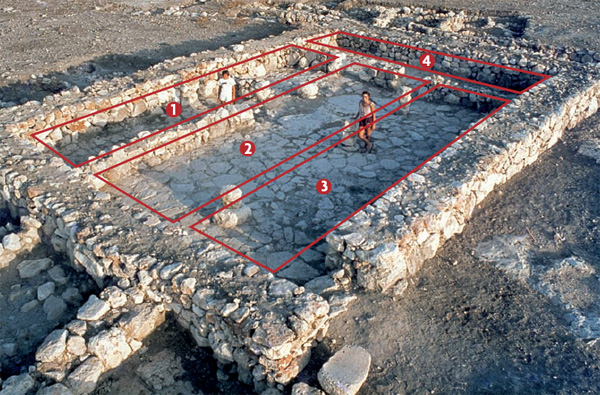
Ethnic identity must be defined in relation to other groups. What are important are not the unifying elements of the group, but the differences one group maintains from another group or groups. Ethnicity is, to a large extent, a result of interaction and negotiations with “other” groups. It is therefore important to identify the boundaries between the groups. As ethnic negotiations develop or as group interactions shift and change, so will the significance of the various cultural traits involved. Furthermore, not only do existing groups (and the relations and interactions between them) change over time, but new groups may emerge. What defines an ethnic group, therefore, is, in the words of anthropologist and ethnographer Fredrik Barth, “self-ascription and ascription by others.”2 Thus, an “archaeological culture” is not the equivalent of an identity group. An “archaeological culture” results not only from group identity, but also from issues of economy, ecology, social status, gender, etc.
If people can change their ethnic identity, however, and even have more than one ethnic identity, how then can we identify ethnic groups in the material world? This kind of question led a number of scholars to doubt the ability of archaeologists to identify ethnic groups in the archaeological record. This skeptical approach, however, is unwarranted.
It is clear that people in the past, just as people today, directly and indirectly used material items to transmit messages about their identity. And many of these material items are available to us in the archaeological record. While ethnic boundaries are not defined simply by an aggregate of cultural traits, they are defined by the idiosyncratic use of specific material and behavioral symbols compared with other groups.3 For example, people use items that can directly transmit messages regarding their 067group affiliation. A yarmulke (or kippa, a small skull cap) sends a clear message regarding the social affiliation of the person who wears it—he is a Jew (and some viewers will identify other, more subtle attributes). Symbols, however, are arbitrary and therefore difficult to identify. We don’t know, for example, which objects were used as symbols by which ancient groups. In many cases, the way items are used differs from one group to another. Ethnically specific behaviors such as dietary habits are a well-known example, as are the cultural uses of space, such as how groups organize their settlements or where and how they bury their dead. Although these differences can result from other distinctions, they might also result from ethnic differences. As an instructive example, consider the “Parting Ways” archaeological site in Plymouth, Massachusetts, where a group of freed slaves settled after the American Revolution.4 Excavations at the site revealed a material culture that, though poorer, was generally similar to that of contemporaneous sites nearby. However, James Deetz, director of the project, observed that “Parting Ways” was distinguished from its neighboring communities by small differences in house construction, trash disposal and community arrangements. These differences could have been overlooked if we analyzed only the artifacts themselves. It is not necessarily the artifacts that are ethnically sensitive, but how they were used that might be important.

An attempt to understand the development of Israelite ethnic identity, therefore, requires an examination of various social aspects of Iron Age groups in order to grasp the meaning of various symbols. We must also trace various behavior patterns over time. Any effort to understand Israel’s ethnogenesis must therefore examine Israelite ethnic identity as part of a larger study of Israelite society.
Instead of looking for the Israelites in Iron Age I, as most studies do, I begin by examining 068the indisputable reality of Israelite ethnic identity in Iron Age II (c. 1000–586 B.C.E.), that is, the period of the Israelite monarchy. This is because practically all archaeologists agree that an ethnic group named “Israel” did exist in Iron Age II. Identifying this group in Iron Age II through some elements of its material culture (but not through its “archaeological culture”) should therefore be much simpler than during Iron Age I, when many question whether such a group even existed. After identifying the material traits—either symbols or patterns of behaviors—that can be connected to the Israelites in a meaningful way in Iron Age II, we will then examine when and how those traits became ethnically meaningful. In other words, in what historical context did certain items gain importance in the ethnic negotiation and boundary maintenance between different groups?
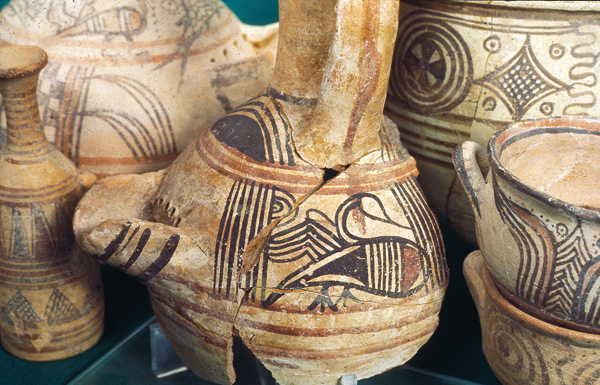
It must be stressed that we are not simply looking for the first time these traits appeared, but also for the context in which they became ethnically important. Identifying the historical context in which these traits gained their ethnic significance will tell us about the situation that caused the group to negotiate its identity vis-à-vis another group—or in other words, the situation that brought the group into existence.
It is also important to distinguish between two different questions: (1) When did a people named Israel first appear? and (2) Where did those people come from? Many discussions of Israel’s ethnogenesis ignore this distinction and unintentionally drift from one question to the other. I am dealing here only with the first question, not the second.b
So let us look at the archaeological context first in Iron Age II.
Patterns of behavior and material items that seem meaningful during Iron Age II include the avoidance of pork, a tradition of not decorating pottery, avoiding imported pottery, male circumcision and use of the four-room house. The common denominator of many of these traits (and others, e.g., burial in simple inhumations during most of this period, the limited use of royal inscriptions) is an ethos of simplicity and perhaps even a form of egalitarian ideology.5 This ethos may well have been used by the Israelites to define their boundaries in relation to other, more hierarchical groups. In short, this ethos helped to differentiate them from others.
Can we trace this from Iron Age II back into Iron Age I—the premonarchic period in Biblical terms? When did those traits become ethnically sensitive and in what historical context? The answer will, one hopes, allow us to determine if we can regard these people as a group with a unique identity and self-awareness, a group that negotiated its identity with (or against) other groups in Iron Age I.
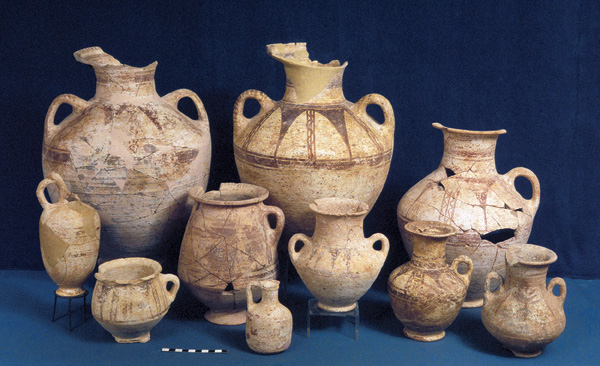
Some of the traits—circumcision and the avoidance of pork—seem like a straightforward way to differentiate this group from the Philistines. The consumption of pork among the Philistines peaked in the final phases of Iron Age I, comprising more than 20 percent of the diet in places where data are available. In most cases this decreases dramatically during Iron Age II. Therefore the time in which avoidance of pork became a meaningful ethnic trait seems to have been Iron Age I, and not later.
The tradition of not decorating pottery could also reflect an attempt to differentiate the Iron Age I highland settlers from the Philistines, whose pottery was highly decorated. The Philistine decorated pottery of Iron Age I disappears during the transition to Iron Age II; hence, the absence of decorated pottery could have become an ethnic marker only in Iron Age I.
This is true for other traits as well, but these two examples are enough to show that these behavioral 069patterns could not have been created after Iron Age I. This in itself makes it highly unlikely that Israelite ethnic identity was created only in Iron Age II.
At the end of Iron Age I and during the transition to Iron Age II (the 11th and beginning of the tenth century B.C.E.), many highland settlements were abandoned. Population became concentrated in fewer settlements, which, as a result, became larger. All the famous small Iron Age I “settlement sites” (traditionally associated with Israelite settlement, such as Shiloh, Giloh, Khirbet Raddana, Ai, Izbet Sartah, Mt. Ebal and many others) were abandoned, while sites like Tell en-Nasbeh (Mizpah), Dan, Bethel and others grew significantly in size and eventually became towns in Iron Age II. The explanation for this process of abandonment is, first and foremost, the Philistine military and economic pressure on the highlands (especially in the Judean hills and the highland territories of Benjamin and southern Samaria). The Israelite-Philistine confrontation reached a peak in this period. This appears to be the historical context in which the already existing patterns of behavior that contrasted the Philistines with the Israelites could become ethnically sensitive and significant. This Philistine military and economic pressure simply added new meaning to existing differences in custom and behavior. Things like circumcision and avoidance of pork became symbols of ethnic identity that served to differentiate one group from the other. Facing the “enemy” or “other” (i.e., the Philistines) who came from the southern coastal plain (and originally from the Aegean world), the highland settlers reinforced a “contrasting” identity that stressed components that were very different from those of the Philistines. Since the latter consumed pork, the Israelites made the avoidance of pork into a “flag” that was used to show how different they were. The same is true for the tradition of using simple pottery. When facing the Philistine threat, the undecorated highland pottery became meaningful in contrast to the highly decorated pottery that the Philistines used.
This would seem sufficient to answer the question as to when Israelite ethnic identity came into existence: in the 11th century B.C.E., within the context of the escalating conflict with the Philistines and the latter’s encroachment from the coastal plain into the highlands.
The highland settlers, who had a “simpler” form of identity, developed an ethnic consciousness because of the asymmetrical confrontation with the much stronger and dominant Philistines.6
After developing this scenario in my research, however, I realized that it had a few problems. While some ethnic patterns of behavior seem to result from the confrontation with the Philistines, other highland traits, such as the avoidance of imported pottery, the usage of undecorated pottery, and the development of an egalitarian ethos, would have been more meaningful for marking the contrast with another, more appropriate “other” in Canaan. All those traits (and others) could have resulted from interaction with the very hierarchical, Egyptian-ruled Canaanite society at the end of the Late Bronze Age—namely the Canaanites themselves.
Another factor that makes it difficult to attribute Israel’s ethnogenesis only to the interaction with the Philistines in the 11th century is the mention of Israel in the late 13th century B.C.E. in the Merneptah Stele. This indicates that in the 13th century the Egyptians were already familiar with a group by that name. Although the Merneptah Stele does not provide us with precise information regarding the location of these “Israelites” or the size or composition of the group, it is more than tempting to connect it with the hundreds of settlements founded at this time in the highland regions of Canaan—exactly where the later Israel is agreed to have existed.
In the Late Bronze Age (1550–1200 B.C.E.), the period that immediately preceded Iron Age I, the Egyptian pharaohs ruled over Canaan. In this period, decorated pottery and imported wares were common in Canaan, indeed more common than in practically any other period, including the 11th century B.C.E. At this time, pottery was imported, 092mainly from the Aegean and Cyprus, but also from other places. Imported pottery is found in large quantities throughout Canaan, at practically every site. Not only is most of this imported pottery decorated, but so is much of the local Canaanite pottery. A similar situation prevails with respect to burials. We are familiar with hundreds of burials from the Late Bronze Age in Canaan, in dozens of different forms.7 This ends with Iron Age I—a period from which almost no burials are known because the deceased were buried in simple inhumations.8
In short, the lack of distinctive Late Bronze Age Canaanite symbols in the highland settlements signifies an active act of differentiation and seems to indicate that the avoidance of those traits—and even the emergence of the egalitarian ethos itself—gained significance at this time. Circumcision and the avoidance of pork are the only patterns that seem to be associated only with the differentiation from the Philistines in a later period.
It thus appears that the beginning of the settlement process in the highlands on both sides of the Jordan River in the second half of the 13th century B.C.E. was accompanied by hostile relations between the highland settlers on the one hand, and the Canaanite city-states and their Egyptian overlords on the other. The former were apparently pushed (or restricted) to the highlands by an Egyptian administration that was strengthening its hold over Canaan at the time. The highland settlers had an asymmetrical relationship with the powerful Egyptian overlords and the Canaanite cities. Asymmetrical relations between groups typically result in the creation of distinct ethnic identities,9 and it is therefore likely that the highland settlers would have developed their own identity under these circumstances. This is the Israel that is mentioned in the Merneptah Stele.
This highland group defined itself as egalitarian in contrast to the highly stratified and diverse Canaanite society, and therefore avoided the use of imported or decorated pottery that was prevalent in Canaan at the time. Decorated and imported wares were a kind of nonverbal communication of Canaanite society in the Late Bronze Age. The differences were important to the various groups living there at the time. Complete avoidance of imported and decorated wares transmitted a strong message of difference.
During the 12th century the Egyptian rulers withdrew from the Canaanite territories. The Canaanite city-state system that characterized the Late Bronze Age was weakened. Egypt lost whatever influence it had in the highlands. At this point, the highland settlers had little interaction with the people of the lowlands. With the absence of any significant external “other,” the highland settlers maintained a symmetrical relationship among themselves, that is, each group of settlers interacted with similar groups and had no connection with a larger or stronger group from outside the highlands. Since it is agreed that ethnic consciousness is promoted by asymmetrical or hierarchical relations between groups, it is likely that the symmetrical relationship that characterized this time period promoted the emergence of “simpler” forms of identity (sometimes labeled totemic identities).10 We may refer to these as “local” or “tribal” identities.
During the 11th century B.C.E., the highland population once again confronted a powerful external “other”—the Philistines. By that time the Philistines had an economic interest in various regions of Judah and probably also southern Samaria. This strong external pressure once again led the highlanders to stress their ethnic identity, this time in relation to the Philistine “other.” In the new ethnic negotiation that ensued, many of the former relevant traits were renegotiated and stressed anew (i.e., undecorated pottery, avoidance of imported pottery, and even the egalitarian ethos), along with new components that were deemed appropriate in the new context (e.g., circumcision and the avoidance of pork). All this left its mark on Israelite identity for hundreds of years, often through a repetitive process of negotiation and renegotiation. Some of those patterns are visible even today.
The “Israel” that is mentioned in the Merneptah Stele is indeed the “Israel” of the Iron Age. And it can be identified archaeologically. The rich archaeological database, and its analysis with appropriate tools, allows us to trace the Israelites and to 094decipher many of the internal and external processes that characterized the group from the beginning of the Iron Age onward.
Finally, you may ask, “What was the role of religion in the process of Israel’s emergence?” This is a very complex issue which deserves a separate and lengthy discussion of its own. Here I can only hint, as others have already done, to the lack of temples in the highland settlements. The situation in the highlands stands in sharp contrast to the reality in Canaanite cities and villages, where temples were abundant. The connection with the egalitarian ethos discussed above seems self-evident, but a more detailed discussion of this issue will be published in a special study devoted to Israelite religion.
This article is based on the author’s book Israel’s Ethnogenesis: Settlement, Interaction, Expansion and Resistance (Equinox, 2007), reviewed in BAR, November/December 2008 (see ReViews). The book was the recipient of the 2009 BAS Publication Award for Best Scholarly Book on Archaeology.
It used to be easy to identify the earliest Israelites. They are referred to in a well-known hieroglyphic stele known as the Merneptah Stele or, sometimes, the Israel Stele. The Egyptian pharaoh Merneptah, the son of Ramesses II, proclaims in this stele dated to the end of the 13th century B.C.E. that “Israel is laid waste, his seed is not.” There is no question about the translation of the hieroglyphic signs: They say “Israel.” Attached to the word “Israel” is a non-phonetic (unpronounced) hieroglyphic sign that indicates this word is a people, not a city-state like the other places […]
You have already read your free article for this month. Please join the BAS Library or become an All Access member of BAS to gain full access to this article and so much more.
Already a library member? Log in here.
Institution user? Log in with your IP address or Username
Footnotes
1.
See “Face to Face: Biblical Minimalists Meet Their Challengers,” BAR 23:04.
2.
See Anson Rainey, “Inside, Outside: Where Did the Israelites Come From?” BAR 34:06.
Endnotes
1.
V. Gordon Childe, The Danube in Prehistory (Oxford: Oxford Univ. Press, 1929), pp. v–vi.
2.
Fredrik Barth, “Introduction” in Ethnic Groups and Boundaries (Boston: Little, Brown and Co., 1969), pp. 11, 13.
3.
R.H. McGuire, “The Study of Ethnicity in Historical Archaeology,” Journal of Anthropological Archaeology 1 (1982), p. 160.
4.
James Deetz, In Small Things Forgotten: The Archaeology of Early American Life (New York: Anchor, 1996), pp. 187–211.
5.
One may ask whether the lack of decorated pottery and elaborate tombs in ancient Israel was more a result of the population’s poverty than an ideology. The issue cannot be dealt with in detail here, but it is clear that Israelite society of Iron Age II was neither poor nor egalitarian. To the contrary, we have clear evidence of social stratification and social classes (including a wealthy population). The lack of decoration (and other features) cannot, therefore, be attributed to social reality, but rather should be interpreted as an expression of ideology. Even in Iron Age I, the simplicity of the culture cannot be attributed to “poverty,” since much simpler (and poorer) societies, such as the Neolithic cultures of the Levant, often did decorate their pottery (and use elaborate tombs, etc.). It is quite clear, therefore, that even in Iron Age I, the lack of decoration (and other features) was a result of an ethos, and not only a reflection of the poverty of the hill country. This is even more clearly the case in Iron Age II.
6.
For the connection between hierarchical, or asymmetrical, relations and the development of ethnic consciousness, see especially John Comaroff and Jean Comaroff, Ethnography and the Historical Imagination (Boulder, CO: Westview Press, 1992), pp. 49–67; see also McGuire, “The Study of Ethnicity in Historical Archaeology”; Geoff Emberling, “Ethnicity in Complex Societies: Archaeological Perspectives,” Journal of Archaeological Research 5 (1997), pp. 295–344; Stephen Shennan, “Introduction: Archaeological Approaches to Cultural Identity,” in J.S. Shennan, ed., Archaeological Approaches to Cultural Identity (London: Unwin Hyman, 1989), pp. 1–32.
7.
See, e.g., Rivka Gonen, Burial Patterns and Cultural Diversity in Late Bronze Age Canaan, American Schools of Oriental Research, Dissertation series 7 (Winona Lake, IN: Eisenbrauns, 1992).
8.
See, e.g., Raz Kletter, “People Without Burials? The Lack of Iron I Burials in the Central Highlands of Palestine,” Israel Exploration Journal 52 (2002), pp. 28–48; Avraham Faust, “ ‘Mortuary Practices, Society and Ideology’: The Lack of Iron Age I Burials in the Highlands in Context,” Israel Exploration Journal 54 (2004), pp. 174–190.
9.
See especially Comaroff and Comaroff, Ethnography and the Historical Imagination.
10.
Comaroff and Comaroff, Ethnography and the Historical Imagination, pp. 49–67.
